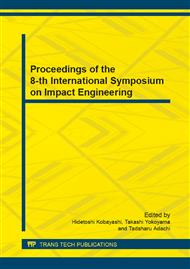p.409
p.415
p.420
p.426
p.431
p.437
p.443
p.449
p.457
Transient Phenomena in Wave Propagation around a Large Suspended Particle in a Water-Filled Tube
Abstract:
Our study focuses on the response of a water-filled polycarbonate tube under axial impact loading to the presence of a single large suspended particle. The particles, composed of steel, aluminum, and polycarbonate, were individually suspended by elastic string along the centerline of the tube. The impact of a free-fall piston initiated pressure waves in the water, called water hammer, and stress waves in the tube, especially at the level of the particle. Hoop strains were measured as impact responses; their distribution indicated that the maximum strains occurred around the particle. These maximum strains are narrowly confined and independent of particle composition. From measurements, hoop strain above the level of the particle become larger with increasing particle mass. We propose a theoretical model that assumes the particle to be a rigid body, and estimate tube responses from the change in area due to the particle’s presence rather than a dependence on particle material. With similar conditions as in experiments, numerical simulations, performed using the software AUTODYN, revealed that the particle motion initiated a reflected pressure wave and created another pressure wave underneath the particle. The transients propagating around the particle are independent of particle material, but composition does affect the attenuation of the reflected pressure wave above the particle.
Info:
Periodical:
Pages:
431-436
Citation:
Online since:
June 2014
Authors:
Price:
Сopyright:
© 2014 Trans Tech Publications Ltd. All Rights Reserved
Share:
Citation:


